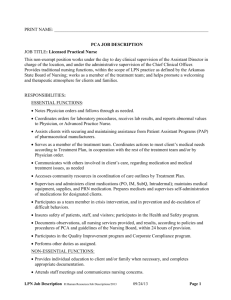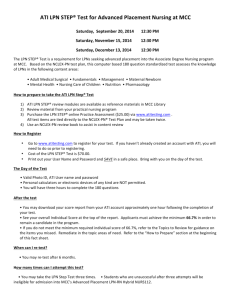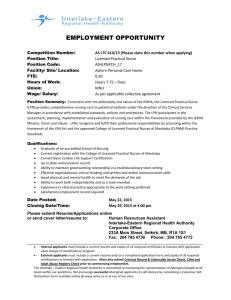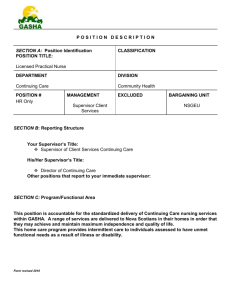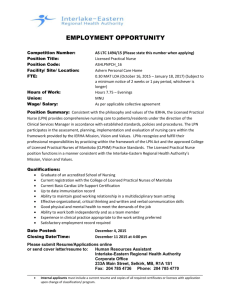Managing Care Assignment UPDATED 2014
advertisement
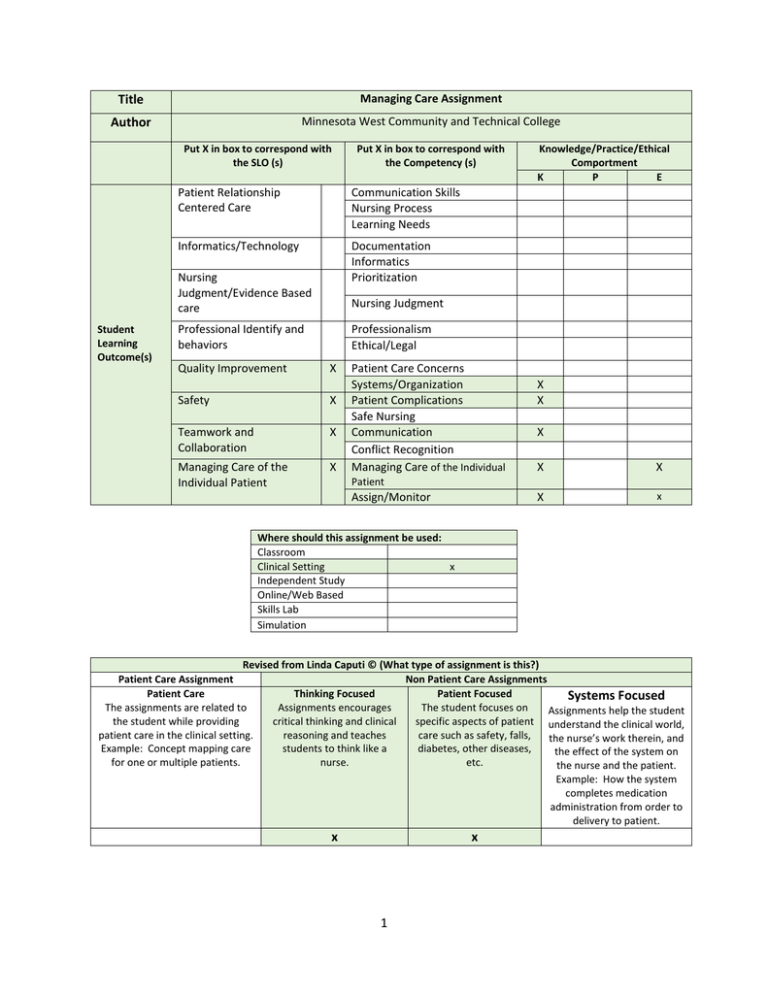
Title Managing Care Assignment Author Minnesota West Community and Technical College Put X in box to correspond with the SLO (s) Patient Relationship Centered Care Communication Skills Nursing Process Learning Needs Informatics/Technology Documentation Informatics Prioritization Nursing Judgment/Evidence Based care Student Learning Outcome(s) Put X in box to correspond with the Competency (s) Knowledge/Practice/Ethical Comportment K P E Nursing Judgment Professional Identify and behaviors Professionalism Ethical/Legal Quality Improvement X Safety X Teamwork and Collaboration X Managing Care of the Individual Patient X Patient Care Concerns Systems/Organization Patient Complications Safe Nursing Communication Conflict Recognition Managing Care of the Individual X X X X X X x Patient Assign/Monitor Where should this assignment be used: Classroom Clinical Setting x Independent Study Online/Web Based Skills Lab Simulation Revised from Linda Caputi © (What type of assignment is this?) Patient Care Assignment Non Patient Care Assignments Patient Care Thinking Focused Patient Focused Systems Focused The assignments are related to Assignments encourages The student focuses on Assignments help the student the student while providing critical thinking and clinical specific aspects of patient understand the clinical world, patient care in the clinical setting. reasoning and teaches care such as safety, falls, the nurse’s work therein, and Example: Concept mapping care students to think like a diabetes, other diseases, the effect of the system on for one or multiple patients. nurse. etc. the nurse and the patient. Example: How the system completes medication administration from order to delivery to patient. x x 1 Student Name: DATE: Managing Care ASSIGNMENT Competencies measured in this assignment: MANAGING CARE - MANAGING CARE COMPETENCY: Identify (K), demonstrate (P), and appreciate (E) one's role in managing care (planning and organizing) within a plan of care for the individual patient in providing quality nursing care under the direction of a RN or licensed HCP. MANAGING CARE - ASSIGN/MONITOR COMPETENCY: Identify (K), assign (P) nursing tasks/activities to other LPN’s, assign and monitor nursing tasks/activities to Unlicensed Assistive Personnel (UAP) and accept (E) accountability for the PN scope of practice. QUALITY IMPROVEMENT – ORGANIZATIONAL/SYSTEM: Describe (K), provide input (P), and appreciate (E) quality improvement methods used to develop or revise policies/procedures, and effectively use resources to support organizational outcomes. SAFETY - SAFE NURSING PRACTICE: Explain (K), demonstrate (P), and value (E) safe nursing practice and the relationship between national safety campaigns and implementation in practice settings. TEAMWORK AND COLLABOARTION- COMMUNICATION SKILLS COMPETENCY: Describe (K), display (P), and value (E) effective communication skills including the responsibility to report to appropriate health care personnel when working with members of the interprofessional teams. Directions: Students will be assigned to a thinking focused learning experience while at their clinical site. After the instructor assigns the student to these activities, the student will complete the written assignment and share findings at post clinical. (There are 5 parts to this assignment). PART I: Assignments Instructions: You will be assigned to follow the LPN who is working in charge of a group of patients at the LTC facility. 1. 2. 3. 4. 5. You will identify how assignments are made to other LPN’s and UAP’s . You will listen to report on the patients with the LPN and watch to see how she/he assures care is completed. Identify how breaks are determined and if adequate care is left on the floor at lunch. Attend patient care conference (with permission) if one is held that shift. Identify how the LPN keeps current with patient lab reports and new doctors’ orders, and who she reports those to. 2 Part I: Assignments Questions Answers MANAGING CARE - MANAGING CARE COMPETENCY: Knowledge MANAGING CARE - ASSIGN/MONITOR COMPETENCY: Knowledge 1. How does the LPN make assignments to other LPN’s and UAP’s considering abilities and needs of patients? Give 3 examples of assigned tasks/activities. Use observation skills and/or ask the LPN as needed. 2. Listen to report and identify 2 ways that the LPN assures care is completed. 3. How are breaks determined? Was adequate care left on the floor at lunch? 4. How does the LPN keep current with patient lab reports and new doctors’ orders, and who does the LPN report those to. Criteria Satisfactory (__points each) Assigning Identifies how LPN assigns care to other LPN’s and UAP’s considering abilities and needs of patients. Gives 3 examples of LPN’s and UAP’s given assigned tasks/activities. Receives report with the LPN and identifies 2 ways that the LPN assures cares are completed. Identifies how breaks are determined and whether floor is adequately staffed at lunch. Identifies how the LPN keeps up with labs and new doctor orders and identifies how and when the LPN reports to the RN. Report & Follow Up Breaks Labs Order Grading Rubric for Managing Care Needs Improvement (__ points each) Identifies who care is assigned to but does not see identify the ability or needs of the patients, or the ability and skills of the workers. Unsatisfactory (__points each) Does not identify how the LPN assigns care or why the tasks/activities are assigned. Receives part of the report with the LPN and identifies 1 way that the LPN assures cares are completed. Does not receive report or identify ways to assure cares are completed. Identifies how breaks are determined but does not identify if adequately staffed at lunch break. Identifies how the LPN keeps up with labs and new doctor orders and has difficulty identifying how and when the LPN reports to the RN. Does not identify how breaks are determined or if adequately staffed at lunch break. Unable to Identify how the LPN keeps up with labs and new doctor orders and unable to identify how and when the LPN reports to the RN. Total 3 Part II: Teamwork and Collaboration: Answer the following questions regarding collaboration and teamwork. Questions Answers TEAMWORK AND COLLABOARTION- COMMUNICATION SKILLS COMPETENCY: Knowledge 1. Identify 2 examples of how teamwork is promoted at this facility. 2. Examine the role of the RN and LPN at this facility; note 2 similarities and 2 differences. 3. Identify 2 barriers to effective teamwork between staff/departments. How do the various departments communicate with each other? 4. 5. Do the various departments/staff collaborate on patient care? Give 2 examples. Do you feel that teamwork is effective at this facility? Give 2 examples to support why you believe it is or 2 suggestions for improvement. Rubric for Grading Teamwork and Collaboration Criteria Satisfactory (__points each) Needs Improvement (__ points each) Q. 1 Identifies 2 examples of how teamwork is promoted in facility Notes 2 similarities and 2 differences in the role of RN and LPN Identifies 2 barriers to effective teamwork. Provides 2 examples of staff/departments collaborating Provides 2 examples of effective teamwork or 2 ways to improve teamwork. Identifies 1 example of how teamwork is promoted in facility Notes 1 similarity and 1 difference in the role of RN and LPN Identifies 1 barrier to effective teamwork. Provides 1 example of staff/departments collaborating Provides 1 example of effective teamwork or 1 way to improve teamwork. Q. 2 Q. 3 Q. 4 Q. 5 Points: Total Points 4 Unsatisfactory (__points each) Does not provide examples of how teamwork is promoted in facility Unable to note differences or similarities. Does not identify barriers to effective teamwork. Does not provide examples of staff/departments collaborating Does not provide examples of effective teamwork or ways to improve it. Part III: Safety and Quality Improvement: Question Answers SAFETY - SAFE NURSING PRACTICE: Knowledge QUALITY IMPROVEMENT – ORGANIZATIONAL/SYSTEM: Knowledge 1. Discuss 2 factors that could hinder the patient’s ability to protect themselves from injury. 2. Identify how a patient’s risk for injury is assessed at this facility? 3. Identify at least 2 potential safety issues in providing care to patients in this facility. 4. Give 2 interventions within the plan of care that are used to prevent patient falls. 5. Give 2 suggestions to improve the safety of patients at this facility. Criteria Q1 Q2 Satisfactory (__points each) Identifies 2 factors that affect patient’s ability to protect themselves from injury. Correctly identifies how a patient’s risk for injury is assessed. Q3 Identifies 2 potential safety issues. Q4 Gives 2 interventions within the plan of care that are used to prevent patient falls. Gives 2 suggestions on how to improve safety at the facility. Q5 Rubric Safety Needs Improvement (__ points each) Identifies 1 factor that affect patient’s ability to protect themselves from injury. Identifies how a patient’s risk for injury is assessed with cues and prompts Identifies 1 potential safety issue in providing care to patients in this facility. Give 1 intervention within the plan of care that is used to prevent patient falls. Gives 1 suggestion on how to improve safety at the facility. Points: Total Points 5 Unsatisfactory (__points each) Unable to identify factors that affect patient’s ability to protect themselves. Unable to identify how a patient’s risk for injury is assessed. Unable to identify potential safety issues in providing care to patients. Unable to give interventions within the plan of care that are used to prevent patient falls. Unable to give suggestions on how to improve safety at the facility. Part IV: Self-Evaluation Questions Answers MANAGING CARE - MANAGING CARE COMPETENCY: Ethical Comportment 1. 2. Evaluate what you learned today about managing care for the individual patient Identify at least 2 strategies to work on in order to better manage care for your group of individual patients. Did you find this assignment beneficial to your learning? Support your answer with 2 examples. 3. Identify 2 effective planning and organizing tasks that you observed today. Identify 2 ways that you could improve on your planning and organizing of care. 4. Explain why it is important to effectively manage care in your work as a LPN. MANAGING CARE - ASSIGN/MONITOR COMPETENCY: Ethical Comportment 5. Explain how effective you were at determining the tasks/activities that were assigned to other LPN’s or UAP’s and how the LPN monitored the UAPs. (Give at least 2 examples). 6. What does it mean for you as a LPN to be accountable for the process of assigning and monitoring tasks/activities for UAP’s and assigning tasks/activities to LPN’s? 7. Criteria Satisfactory (__points each) Self-Evaluation Rubric Needs Improvement (__ points each) Identifies 2 strategies to work on to better manage the care of individual patients. Identifies 1 strategy to work on to better manage the care of individual patients. Identifies 2 examples of benefits from assignment. Identifies 2 effective planning and organizing tasks and 2 ways to improve. Identifies reasons why it is important to manage care. Gives 2 examples of how tasks were assigned Identifies 1 example of a benefit from assignment. Identifies 1 effective planning and organizing task and 1 way to improve Unsatisfactory (__points each) Q1 Q2 Q3 Q4 Q5 Needs prompts and cues to identify why it is important to manage care. Gives 1 example of how tasks were assigned Unable to identify strategies to work on to better manage the care of individual patients. Unable to identify benefits from assignments. Unable to identify effective planning and organization or ways to improve. Unable to identify why it is important to manage care. Unable to give example of how tasks were assigned Q6 Correctly Identifies what it means be accountable for the process of Unable to correctly identify what it means to be accountable 6 assigning and monitoring tasks/activities for UAPs and assigning tasks/activities to LPNs. Partially correct in identifying what it means to be accountable for the process of assigning and monitoring tasks/activities for UAPs and for assigning tasks/ activities to LPNs. for the process of assigning and monitoring tasks/activities. Points Total Points Competency Part I: Managing Care Skills: Assignment and Delegation Competency Part II: Teamwork and Collaboration: Communication Competency Part III: Safety : Patient Complications Competency Quality Improvement: Systems Competency Part IV: Managing Care: Managing Care Competency Total: Revised from assignment developed by MnWest Nursing Program, Minnesota 7 Possible Points Student’s Points
